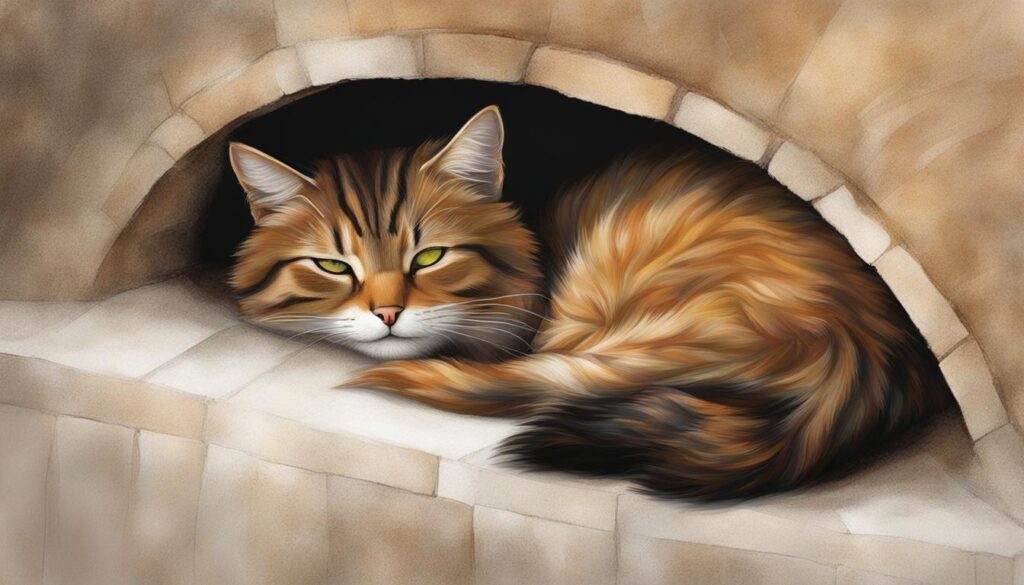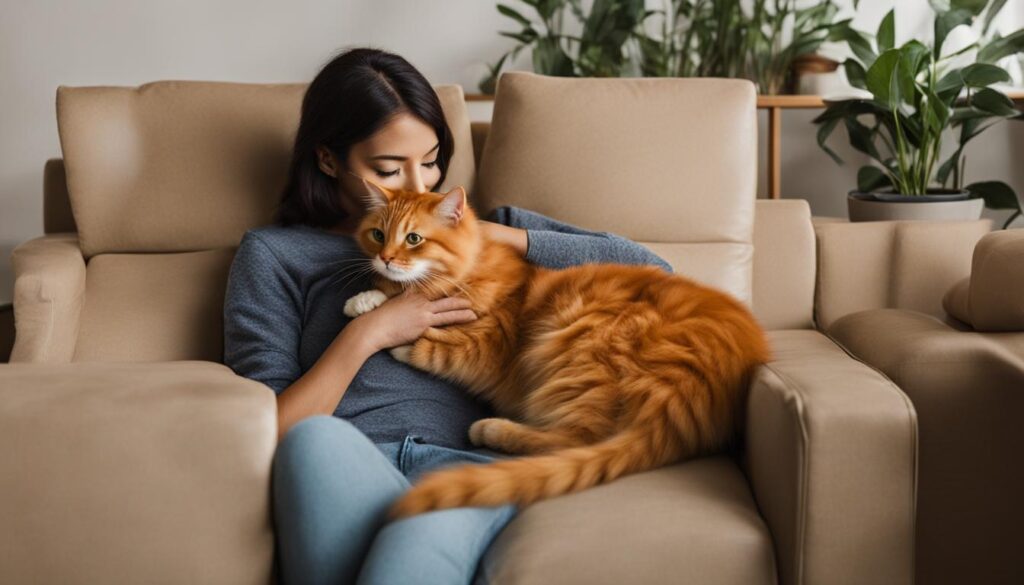Safe & Gentle Guide: How to Pick Up a Cat
Welcome to our safe and gentle guide on how to pick up a cat. Whether you’re a new cat owner or simply looking for proper techniques to handle cats, this article will provide you with essential tips for lifting a cat safely and comfortably.
Knowing how to pick up a cat correctly is crucial to ensure both your safety and the cat’s well-being. Improper handling can lead to discomfort, scratches, or bites. By following these cat pick up techniques, you’ll be able to establish a positive connection and create a trusting bond with your feline friend.
Key Takeaways:
- Approach the cat slowly and only if it seems at ease and comfortable being handled.
- Use both hands to gently lift the cat from its chest and hindquarters, providing support and stability.
- Avoid picking up a cat by the scruff of its neck, as it can cause pain and injury, especially in older cats.
- Pay attention to the cat’s body language and behavior to determine if it wants to be picked up or released.
- When holding a cat, keep it close to your body and provide a sense of security while avoiding tail restriction.
Approaching the Cat
When it comes to approaching a cat, it’s important to remember that felines have their own unique way of communicating. By understanding their body language and behavior, you can create a positive and comfortable interaction.
First and foremost, approach the cat slowly and allow it time to observe and sense your presence. Sudden movements or surprises can startle cats, leading to feelings of fear or aggression. Instead, move calmly and deliberately to establish a sense of trust.
Communicate with the cat using a calm and soothing voice. Using a higher-pitched tone may help to convey friendliness and reassurance. Take the time to gauge the cat’s response and adjust your approach accordingly.
Avoid approaching the cat from behind as it can be perceived as threatening. Instead, approach from the side, giving the cat a clear view of your intentions. This approach allows the cat to feel more comfortable and in control of the interaction.
Pay close attention to the cat’s body language, as it can provide valuable insights into their state of mind. A wagging tail or flattening ears may indicate discomfort or fear, suggesting that the cat may not be ready for interaction. Respect their boundaries and give them space if they exhibit these behaviors.
Remember, every cat is unique, and their responses may vary. It’s important to be patient and observant, allowing the cat to guide the interaction at their own pace.
“Approaching a cat with patience and respect is key to building trust and establishing a positive connection.”
Introducing Yourself to the Cat
When it comes to introducing yourself to a cat, patience and trust-building are key. Cats can be cautious and may take some time to warm up to new people. To establish a bond with the cat, try these gentle and affectionate approaches:
- Gently pet the cat’s cheeks, forehead, or behind the ears. These areas are often a cat’s favorite spots for petting

- Mimic how cats interact with each other by nuzzling or rubbing against them. This can help the cat feel more comfortable and familiar with your presence.
- Use a calm and soothing tone of voice when communicating with the cat. Cats respond well to soft-spoken words and gentle sounds.
Remember, gaining a cat’s trust takes time. Be patient and allow the cat to approach you on its terms. Avoid making sudden movements or loud noises that may startle the cat.
Determining If the Cat Wants to Be Picked Up
Cats are known for their independent nature, and not all cats enjoy being held or picked up. It’s important to be able to read their body language and understand their willingness to be handled. By paying attention to specific signs, you can determine whether a cat is open to being picked up or if it would prefer to be left alone.
Signs a Cat Wants to Be Picked Up:
- A high-held tail: When a cat raises its tail in a relaxed manner, it often indicates a friendly and welcoming attitude. This suggests that the cat may be open to being picked up.
- Perked-up ears: Ears that are alert and facing forward indicate that the cat is attentive and engaged. It shows a positive response to your presence and may signify its willingness to be held.
When a cat exhibits these behaviors, it’s generally a good sign that it is comfortable and may be receptive to being picked up. However, it’s essential to understand that each cat is unique, and their preferences may vary.
Warning Signs of a Cat’s Discomfort:
- Flattened ears: Ears pressed tightly to the head suggest fear or discomfort. This is a clear indication that the cat does not want to be picked up and should be left alone.
- Dilated pupils: Wide and dilated pupils can signify stress or anxiety in cats. If a cat’s pupils are noticeably large, it may indicate that it is not comfortable or willing to be picked up.
- Tense body language: A cat that is rigid or has its body tightly hunched may be exhibiting signs of distress or unease. This suggests that the cat is not in the mood for interaction and should not be picked up.
- Attempts to run away or swat: If a cat tries to escape from your reach or shows signs of aggression, such as swatting with its paws, it’s important to respect its boundaries and refrain from picking it up.
Understanding these warning signs is crucial in respecting a cat’s boundaries and ensuring its comfort. It’s important to teach children about these signs and encourage gentle interactions with cats only when the cat is calm and relaxed.
Observing a cat’s body language is key to determining its willingness to be held or picked up. By paying attention to the signs of comfort or discomfort, you can create a harmonious and enjoyable interaction with your feline friend.
Proper Technique for Picking Up a Cat
When it comes to lifting a cat, using the proper technique is crucial for both your safety and the cat’s comfort. Follow these steps to ensure a secure and stress-free experience.
Step 1: Provide Support
To lift a cat, first place one hand under its chest, behind its front legs. This will provide support and stability to the cat’s upper body.
Step 2: Support the Hindquarters
Next, use your other hand to support the cat’s hindquarters. This ensures that both ends of the cat are secure and stable during the lifting process. Remember to be gentle and maintain a firm grip on the cat.
Step 3: Lift Gently
Gently lift the cat, keeping it close to your body. This provides a sense of security for the cat and helps them feel safe. Avoid jerky or sudden movements to prevent startling the cat.
Step 4: Maintain Comfortable Posture
Hold the cat against your chest, with its head above its body. This posture allows the cat to maintain a natural and comfortable position while being held. Make sure not to compress the cat’s neck or restrict its breathing.
Step 5: Avoid Picking Up by the Scruff
It’s important to avoid picking up a cat by the scruff of its neck, especially if it is older. This method, commonly used with kittens, can cause pain and injury to adult cats. Stick to the technique described above for maximum comfort and safety.
Step 6: Be Mindful of the Cat’s Response
Observe the cat’s body language and response throughout the process. If the cat shows signs of discomfort or agitation, it may be best to release it and try again later. Always prioritize the well-being and comfort of the cat above all.
Remember, lifting a cat properly promotes a positive and trusting relationship between you and your feline companion. By supporting the cat’s body, maintaining a secure grip, and being mindful of their comfort, you can ensure a safe and pleasant experience for both of you.

| Benefits of Proper Technique for Picking Up a Cat | Risks of Improper Technique |
|---|---|
| Provides a sense of security for the cat | Potential discomfort or injury to the cat |
| Maintains a comfortable posture for the cat | Increased risk of dropping or mishandling the cat |
| Builds trust and strengthens the bond between you and the cat | Unwanted scratching or biting from an unhappy cat |
Knowing When to Put the Cat Down
In order to create a positive and comfortable experience for both you and your cat, it’s important to understand when to put the cat down. Paying attention to the cat’s body language and behavior while holding it can give you valuable cues. Look out for the following signs:
“If the cat becomes restless, tries to escape, or shows signs of agitation, it’s time to put the cat down.”
Holding a cat against its will can cause discomfort and potentially lead to scratches or bites. It’s essential to respect the cat’s boundaries and let it go when it indicates it wants to be released. Ignoring these signs of discomfort can lead to a strained relationship with your cat and may make future handling more challenging.
Remember, cats have their own preferences and personalities, and not all cats enjoy being held for extended periods. If your cat seems uncomfortable or stressed, it’s best to allow them the freedom to move around and find a comfortable space.
Understanding your cat’s limits and responding accordingly will help foster a trusting and positive bond between you and your furry friend.
| Signs a Cat Wants to be Released | Cat’s Discomfort While Being Held |
|---|---|
|
|
Holding a Cat Safely and Comfortably
When it comes to holding a cat, it’s important to prioritize their comfort and safety. Here are some helpful tips to ensure a secure and comfortable grip:
- Hold the cat securely but not too tightly: It’s essential to find the right balance when holding a cat. Make sure your grip is firm enough to provide stability, but not so tight that it restricts their movement. This allows the cat to wiggle if needed while still being held securely.
- Support the cat’s body with both hands: To distribute the weight evenly and prevent any strain on the cat’s body, use both hands to support them. Place one hand under the cat’s chest, behind its front legs, and the other hand supporting the hindquarters. This technique ensures that both ends of the cat are secure and stable.
- Keep the cat close to your body: Holding the cat against your body provides them with a sense of security. It’s important to cradle them close, with their head above their body, allowing them to feel safe in your arms.
- Avoid restricting the cat’s tail: Some cats may find having their tails restricted uncomfortable. To ensure their comfort, avoid holding or squeezing their tail while lifting or while they are in your arms.
- Provide stability and firmness: Cats appreciate stability and a sense of security when being held. It’s important to maintain a firm grip and avoid any sudden movements that may startle or destabilize them. This helps the cat feel safe and comfortable.
By following these tips for holding a cat, you can create a positive and secure experience for both you and your feline friend.
Providing a visual guide, the image above illustrates the proper technique for holding a cat securely and comfortably, with both hands supporting the cat’s body and avoiding any restriction of the tail.
Conclusion
Picking up a cat safely and handling it with care is crucial for creating a positive and stress-free experience for both you and the cat. Understanding the cat’s body language and preferences is key to successful cat handling. By approaching the cat slowly and respectfully, you can establish trust and build a bond with the feline.
Using proper lifting techniques is vital to ensure the cat’s comfort and safety. Always use both hands to provide support, lifting the cat gently from its chest and hindquarters. Avoid picking up a cat by the scruff of its neck, as this can cause discomfort and potential injury.
While holding the cat, pay attention to its signals and behavior. If the cat shows signs of agitation, such as restlessness or attempts to escape, it’s important to respect its boundaries and put the cat down. Holding the cat securely but not too tightly, and keeping it close to your body, provides a sense of security for the cat.
Remember, each cat is unique, and it may take time and patience to develop a trusting relationship. By following the best practices of cat handling and respecting the cat’s boundaries, you can enhance the bond and create a positive interaction with your feline friend.
FAQ
How should I approach a cat?
Approach the cat slowly and allow it to see and sense your presence. Use a calm and soothing voice to communicate with the cat. Avoid surprising the cat by approaching from behind. It’s best to approach from the side.
How can I gain a cat’s trust?
Take time to allow the cat to warm up to you and show signs of trust. Show affection by gently petting the cat’s cheeks, forehead, or behind the ears. Mimicking the way cats interact with each other can help establish a bond.
How can I tell if a cat wants to be picked up?
Cats will often display clear signs indicating whether they want to be picked up or not. Positive signs include a tail held high and ears perked up, indicating friendliness and trust. Signs of discomfort or unwillingness to be held include flattened ears, dilated pupils, tense body language, and attempts to run away or swat.
What is the proper technique for picking up a cat?
Place one hand under the cat’s chest, behind its front legs, to provide support. Use the other hand to support the cat’s hindquarters, ensuring both ends are secure and stable. Lift the cat gently, keeping it close to your body. Hold the cat against your chest, with its head above its body, to maintain a comfortable posture. Avoid picking up a cat by the scruff of its neck.
When should I put the cat down?
Pay attention to the cat’s body language and behavior while holding it. If the cat becomes restless, tries to escape, or shows signs of agitation, it’s time to put the cat down. Holding the cat against its will can cause discomfort and potentially lead to scratches or bites.
How can I hold a cat safely and comfortably?
Hold the cat securely but not too tightly to allow it to wiggle if needed. Use both hands to support the cat’s body, with one hand under the chest and the other supporting the hindquarters. Keep the cat close to your body and avoid restricting its tail. Provide stability and firmness while holding the cat to make it feel secure and comfortable.
Is it safe to pick up a cat?
Picking up a cat requires understanding their body language and preferences. By approaching the cat slowly, gaining its trust, and using proper lifting techniques, you can safely and comfortably pick up a cat. It’s important to pay attention to the cat’s signals and respect its boundaries.


